Cloud Migration in Cloud Computing: A Comprehensive Research Report
VerifiedAdded on 2023/06/07
|10
|3605
|288
Report
AI Summary
This report, titled "Cloud Computing and Cloud Migration," delves into the intricacies of cloud migration, examining various research papers and studies on the topic. The report begins by discussing the challenges of mobile cloud computing, including limitations and disruptions, and how these can be addressed through external resource providers. It then explores security issues in cloud migration, emphasizing the importance of encryption algorithms. Furthermore, the report analyzes cloud migration research, highlighting the need for more concrete studies and comparing existing frameworks. It also addresses security threats in cloud computing, the importance of data surveillance, and the potential of dynamic task migration in mobile cloud systems. Interoperability of cloud services, distributed application processing frameworks, and the current state of mobile cloud computing are also examined. The report provides a comprehensive overview of the existing research, challenges, and future directions in cloud computing and cloud migration.
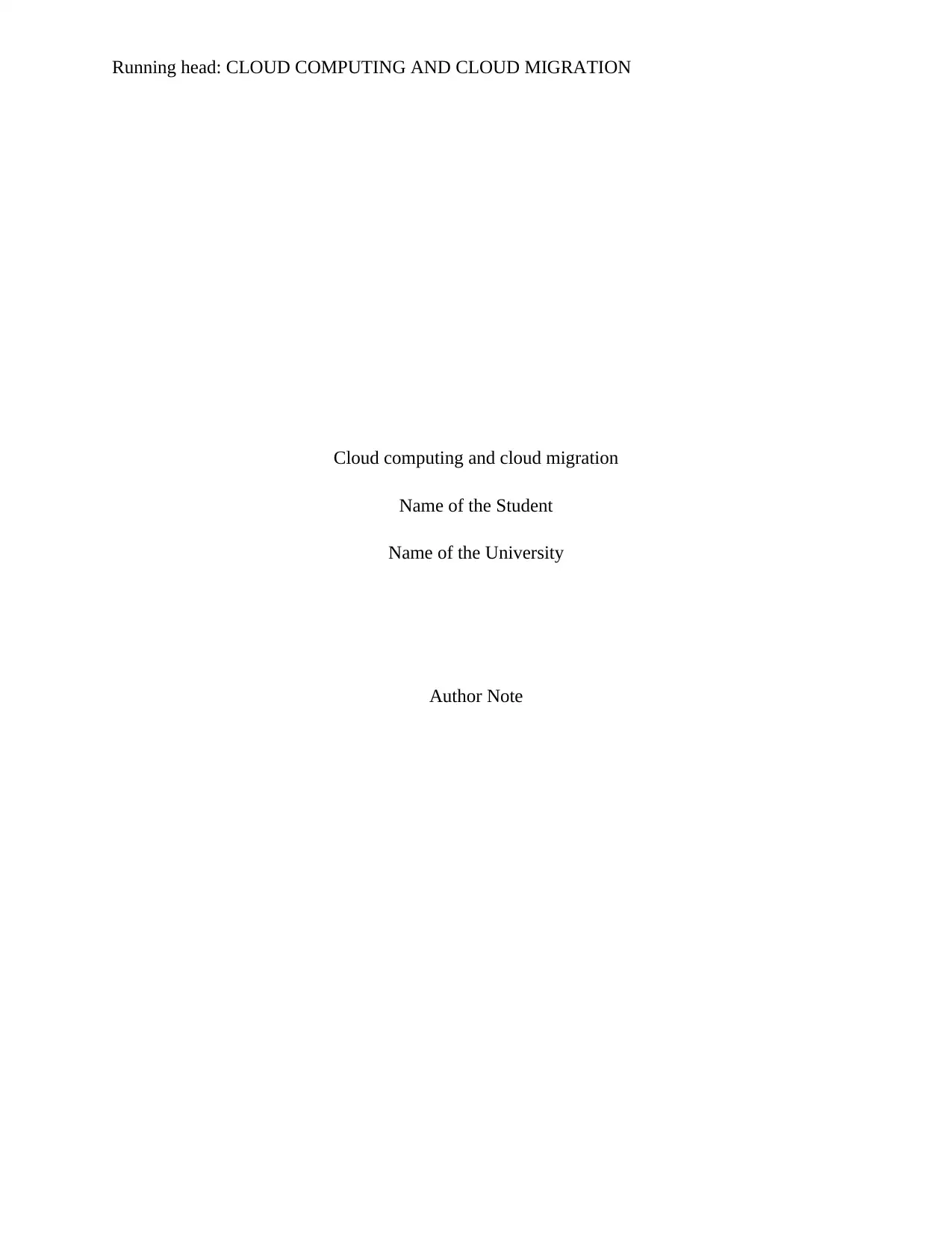
Running head: CLOUD COMPUTING AND CLOUD MIGRATION
Cloud computing and cloud migration
Name of the Student
Name of the University
Author Note
Cloud computing and cloud migration
Name of the Student
Name of the University
Author Note
Paraphrase This Document
Need a fresh take? Get an instant paraphrase of this document with our AI Paraphraser
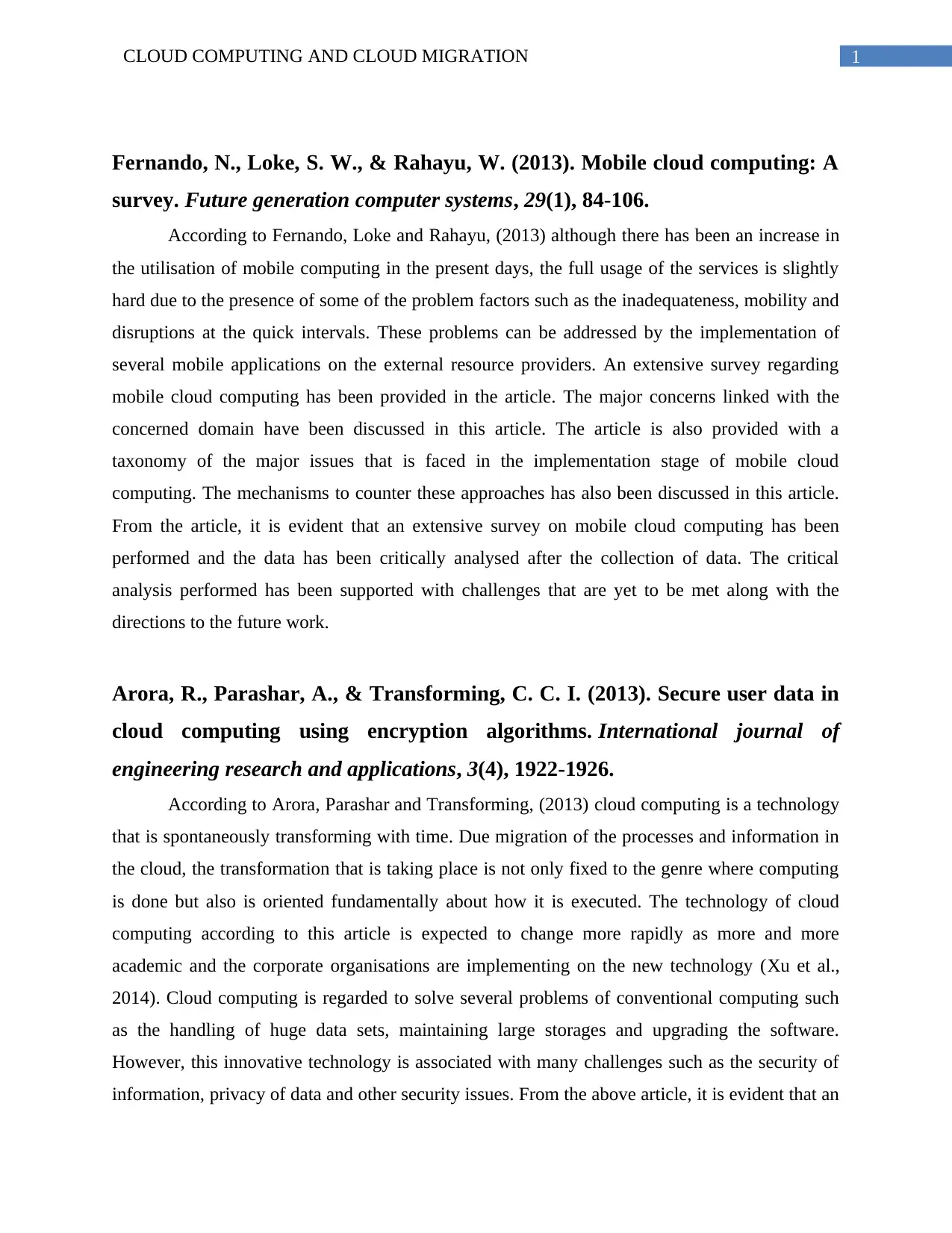
1CLOUD COMPUTING AND CLOUD MIGRATION
Fernando, N., Loke, S. W., & Rahayu, W. (2013). Mobile cloud computing: A
survey. Future generation computer systems, 29(1), 84-106.
According to Fernando, Loke and Rahayu, (2013) although there has been an increase in
the utilisation of mobile computing in the present days, the full usage of the services is slightly
hard due to the presence of some of the problem factors such as the inadequateness, mobility and
disruptions at the quick intervals. These problems can be addressed by the implementation of
several mobile applications on the external resource providers. An extensive survey regarding
mobile cloud computing has been provided in the article. The major concerns linked with the
concerned domain have been discussed in this article. The article is also provided with a
taxonomy of the major issues that is faced in the implementation stage of mobile cloud
computing. The mechanisms to counter these approaches has also been discussed in this article.
From the article, it is evident that an extensive survey on mobile cloud computing has been
performed and the data has been critically analysed after the collection of data. The critical
analysis performed has been supported with challenges that are yet to be met along with the
directions to the future work.
Arora, R., Parashar, A., & Transforming, C. C. I. (2013). Secure user data in
cloud computing using encryption algorithms. International journal of
engineering research and applications, 3(4), 1922-1926.
According to Arora, Parashar and Transforming, (2013) cloud computing is a technology
that is spontaneously transforming with time. Due migration of the processes and information in
the cloud, the transformation that is taking place is not only fixed to the genre where computing
is done but also is oriented fundamentally about how it is executed. The technology of cloud
computing according to this article is expected to change more rapidly as more and more
academic and the corporate organisations are implementing on the new technology (Xu et al.,
2014). Cloud computing is regarded to solve several problems of conventional computing such
as the handling of huge data sets, maintaining large storages and upgrading the software.
However, this innovative technology is associated with many challenges such as the security of
information, privacy of data and other security issues. From the above article, it is evident that an
Fernando, N., Loke, S. W., & Rahayu, W. (2013). Mobile cloud computing: A
survey. Future generation computer systems, 29(1), 84-106.
According to Fernando, Loke and Rahayu, (2013) although there has been an increase in
the utilisation of mobile computing in the present days, the full usage of the services is slightly
hard due to the presence of some of the problem factors such as the inadequateness, mobility and
disruptions at the quick intervals. These problems can be addressed by the implementation of
several mobile applications on the external resource providers. An extensive survey regarding
mobile cloud computing has been provided in the article. The major concerns linked with the
concerned domain have been discussed in this article. The article is also provided with a
taxonomy of the major issues that is faced in the implementation stage of mobile cloud
computing. The mechanisms to counter these approaches has also been discussed in this article.
From the article, it is evident that an extensive survey on mobile cloud computing has been
performed and the data has been critically analysed after the collection of data. The critical
analysis performed has been supported with challenges that are yet to be met along with the
directions to the future work.
Arora, R., Parashar, A., & Transforming, C. C. I. (2013). Secure user data in
cloud computing using encryption algorithms. International journal of
engineering research and applications, 3(4), 1922-1926.
According to Arora, Parashar and Transforming, (2013) cloud computing is a technology
that is spontaneously transforming with time. Due migration of the processes and information in
the cloud, the transformation that is taking place is not only fixed to the genre where computing
is done but also is oriented fundamentally about how it is executed. The technology of cloud
computing according to this article is expected to change more rapidly as more and more
academic and the corporate organisations are implementing on the new technology (Xu et al.,
2014). Cloud computing is regarded to solve several problems of conventional computing such
as the handling of huge data sets, maintaining large storages and upgrading the software.
However, this innovative technology is associated with many challenges such as the security of
information, privacy of data and other security issues. From the above article, it is evident that an
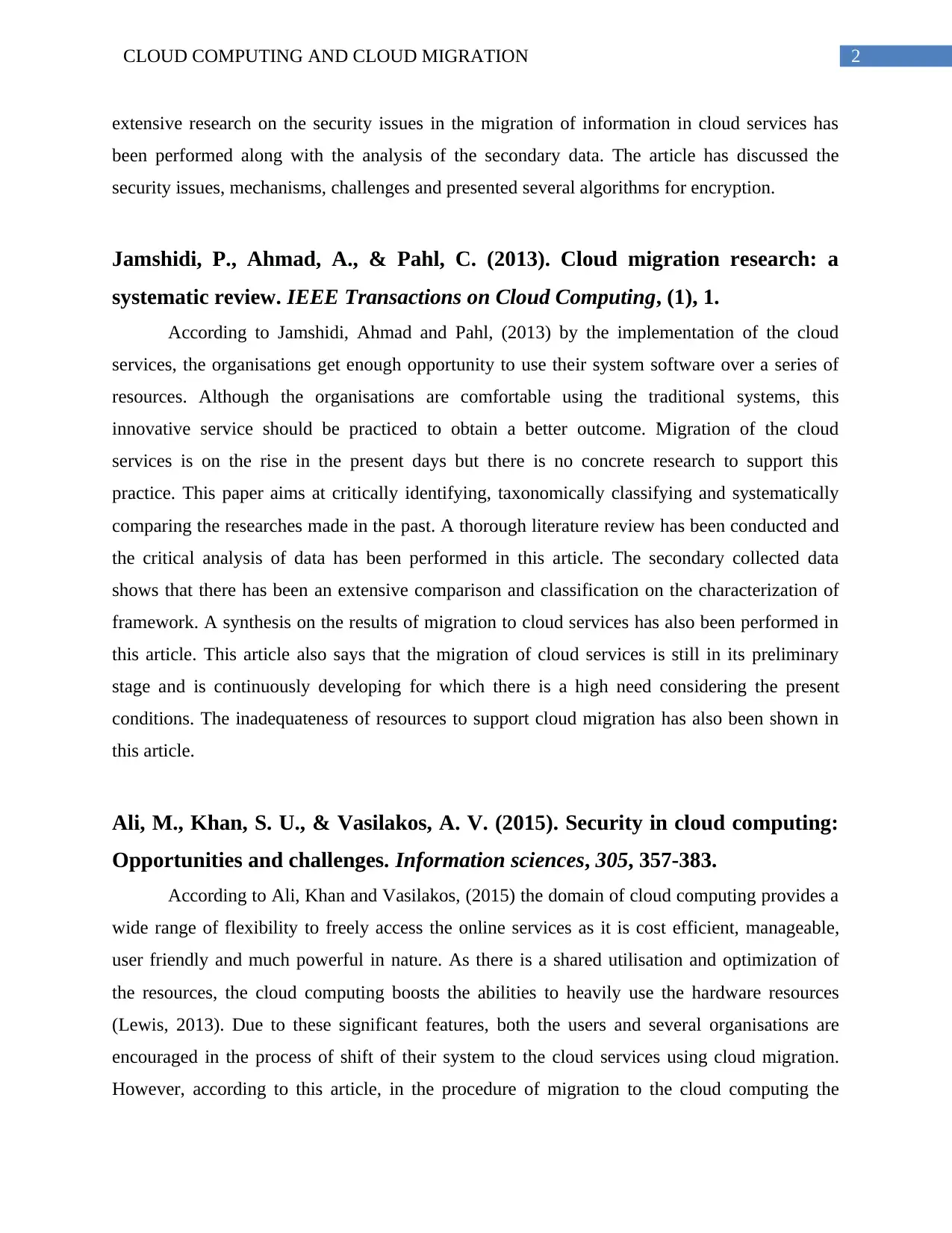
2CLOUD COMPUTING AND CLOUD MIGRATION
extensive research on the security issues in the migration of information in cloud services has
been performed along with the analysis of the secondary data. The article has discussed the
security issues, mechanisms, challenges and presented several algorithms for encryption.
Jamshidi, P., Ahmad, A., & Pahl, C. (2013). Cloud migration research: a
systematic review. IEEE Transactions on Cloud Computing, (1), 1.
According to Jamshidi, Ahmad and Pahl, (2013) by the implementation of the cloud
services, the organisations get enough opportunity to use their system software over a series of
resources. Although the organisations are comfortable using the traditional systems, this
innovative service should be practiced to obtain a better outcome. Migration of the cloud
services is on the rise in the present days but there is no concrete research to support this
practice. This paper aims at critically identifying, taxonomically classifying and systematically
comparing the researches made in the past. A thorough literature review has been conducted and
the critical analysis of data has been performed in this article. The secondary collected data
shows that there has been an extensive comparison and classification on the characterization of
framework. A synthesis on the results of migration to cloud services has also been performed in
this article. This article also says that the migration of cloud services is still in its preliminary
stage and is continuously developing for which there is a high need considering the present
conditions. The inadequateness of resources to support cloud migration has also been shown in
this article.
Ali, M., Khan, S. U., & Vasilakos, A. V. (2015). Security in cloud computing:
Opportunities and challenges. Information sciences, 305, 357-383.
According to Ali, Khan and Vasilakos, (2015) the domain of cloud computing provides a
wide range of flexibility to freely access the online services as it is cost efficient, manageable,
user friendly and much powerful in nature. As there is a shared utilisation and optimization of
the resources, the cloud computing boosts the abilities to heavily use the hardware resources
(Lewis, 2013). Due to these significant features, both the users and several organisations are
encouraged in the process of shift of their system to the cloud services using cloud migration.
However, according to this article, in the procedure of migration to the cloud computing the
extensive research on the security issues in the migration of information in cloud services has
been performed along with the analysis of the secondary data. The article has discussed the
security issues, mechanisms, challenges and presented several algorithms for encryption.
Jamshidi, P., Ahmad, A., & Pahl, C. (2013). Cloud migration research: a
systematic review. IEEE Transactions on Cloud Computing, (1), 1.
According to Jamshidi, Ahmad and Pahl, (2013) by the implementation of the cloud
services, the organisations get enough opportunity to use their system software over a series of
resources. Although the organisations are comfortable using the traditional systems, this
innovative service should be practiced to obtain a better outcome. Migration of the cloud
services is on the rise in the present days but there is no concrete research to support this
practice. This paper aims at critically identifying, taxonomically classifying and systematically
comparing the researches made in the past. A thorough literature review has been conducted and
the critical analysis of data has been performed in this article. The secondary collected data
shows that there has been an extensive comparison and classification on the characterization of
framework. A synthesis on the results of migration to cloud services has also been performed in
this article. This article also says that the migration of cloud services is still in its preliminary
stage and is continuously developing for which there is a high need considering the present
conditions. The inadequateness of resources to support cloud migration has also been shown in
this article.
Ali, M., Khan, S. U., & Vasilakos, A. V. (2015). Security in cloud computing:
Opportunities and challenges. Information sciences, 305, 357-383.
According to Ali, Khan and Vasilakos, (2015) the domain of cloud computing provides a
wide range of flexibility to freely access the online services as it is cost efficient, manageable,
user friendly and much powerful in nature. As there is a shared utilisation and optimization of
the resources, the cloud computing boosts the abilities to heavily use the hardware resources
(Lewis, 2013). Due to these significant features, both the users and several organisations are
encouraged in the process of shift of their system to the cloud services using cloud migration.
However, according to this article, in the procedure of migration to the cloud computing the
⊘ This is a preview!⊘
Do you want full access?
Subscribe today to unlock all pages.

Trusted by 1+ million students worldwide
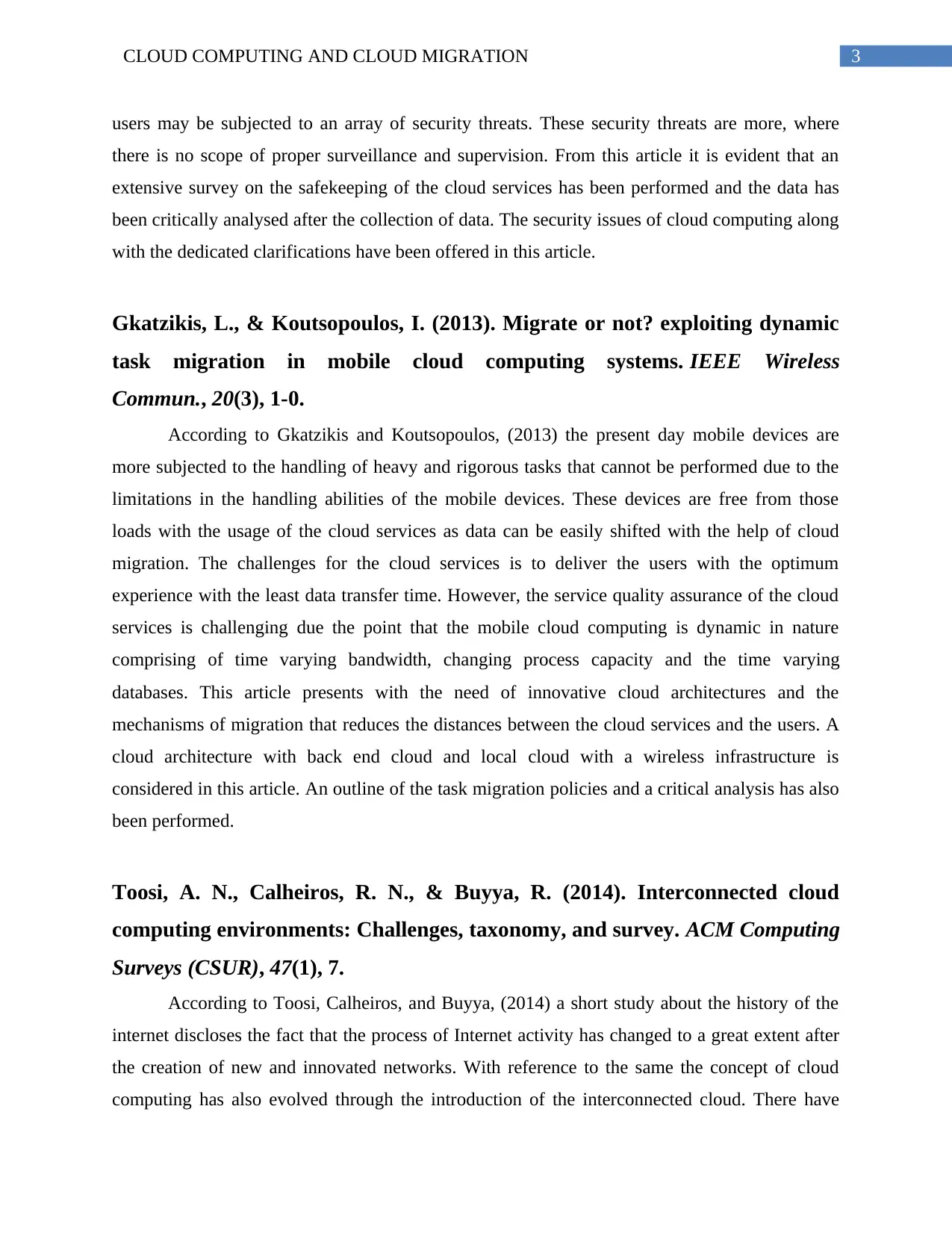
3CLOUD COMPUTING AND CLOUD MIGRATION
users may be subjected to an array of security threats. These security threats are more, where
there is no scope of proper surveillance and supervision. From this article it is evident that an
extensive survey on the safekeeping of the cloud services has been performed and the data has
been critically analysed after the collection of data. The security issues of cloud computing along
with the dedicated clarifications have been offered in this article.
Gkatzikis, L., & Koutsopoulos, I. (2013). Migrate or not? exploiting dynamic
task migration in mobile cloud computing systems. IEEE Wireless
Commun., 20(3), 1-0.
According to Gkatzikis and Koutsopoulos, (2013) the present day mobile devices are
more subjected to the handling of heavy and rigorous tasks that cannot be performed due to the
limitations in the handling abilities of the mobile devices. These devices are free from those
loads with the usage of the cloud services as data can be easily shifted with the help of cloud
migration. The challenges for the cloud services is to deliver the users with the optimum
experience with the least data transfer time. However, the service quality assurance of the cloud
services is challenging due the point that the mobile cloud computing is dynamic in nature
comprising of time varying bandwidth, changing process capacity and the time varying
databases. This article presents with the need of innovative cloud architectures and the
mechanisms of migration that reduces the distances between the cloud services and the users. A
cloud architecture with back end cloud and local cloud with a wireless infrastructure is
considered in this article. An outline of the task migration policies and a critical analysis has also
been performed.
Toosi, A. N., Calheiros, R. N., & Buyya, R. (2014). Interconnected cloud
computing environments: Challenges, taxonomy, and survey. ACM Computing
Surveys (CSUR), 47(1), 7.
According to Toosi, Calheiros, and Buyya, (2014) a short study about the history of the
internet discloses the fact that the process of Internet activity has changed to a great extent after
the creation of new and innovated networks. With reference to the same the concept of cloud
computing has also evolved through the introduction of the interconnected cloud. There have
users may be subjected to an array of security threats. These security threats are more, where
there is no scope of proper surveillance and supervision. From this article it is evident that an
extensive survey on the safekeeping of the cloud services has been performed and the data has
been critically analysed after the collection of data. The security issues of cloud computing along
with the dedicated clarifications have been offered in this article.
Gkatzikis, L., & Koutsopoulos, I. (2013). Migrate or not? exploiting dynamic
task migration in mobile cloud computing systems. IEEE Wireless
Commun., 20(3), 1-0.
According to Gkatzikis and Koutsopoulos, (2013) the present day mobile devices are
more subjected to the handling of heavy and rigorous tasks that cannot be performed due to the
limitations in the handling abilities of the mobile devices. These devices are free from those
loads with the usage of the cloud services as data can be easily shifted with the help of cloud
migration. The challenges for the cloud services is to deliver the users with the optimum
experience with the least data transfer time. However, the service quality assurance of the cloud
services is challenging due the point that the mobile cloud computing is dynamic in nature
comprising of time varying bandwidth, changing process capacity and the time varying
databases. This article presents with the need of innovative cloud architectures and the
mechanisms of migration that reduces the distances between the cloud services and the users. A
cloud architecture with back end cloud and local cloud with a wireless infrastructure is
considered in this article. An outline of the task migration policies and a critical analysis has also
been performed.
Toosi, A. N., Calheiros, R. N., & Buyya, R. (2014). Interconnected cloud
computing environments: Challenges, taxonomy, and survey. ACM Computing
Surveys (CSUR), 47(1), 7.
According to Toosi, Calheiros, and Buyya, (2014) a short study about the history of the
internet discloses the fact that the process of Internet activity has changed to a great extent after
the creation of new and innovated networks. With reference to the same the concept of cloud
computing has also evolved through the introduction of the interconnected cloud. There have
Paraphrase This Document
Need a fresh take? Get an instant paraphrase of this document with our AI Paraphraser
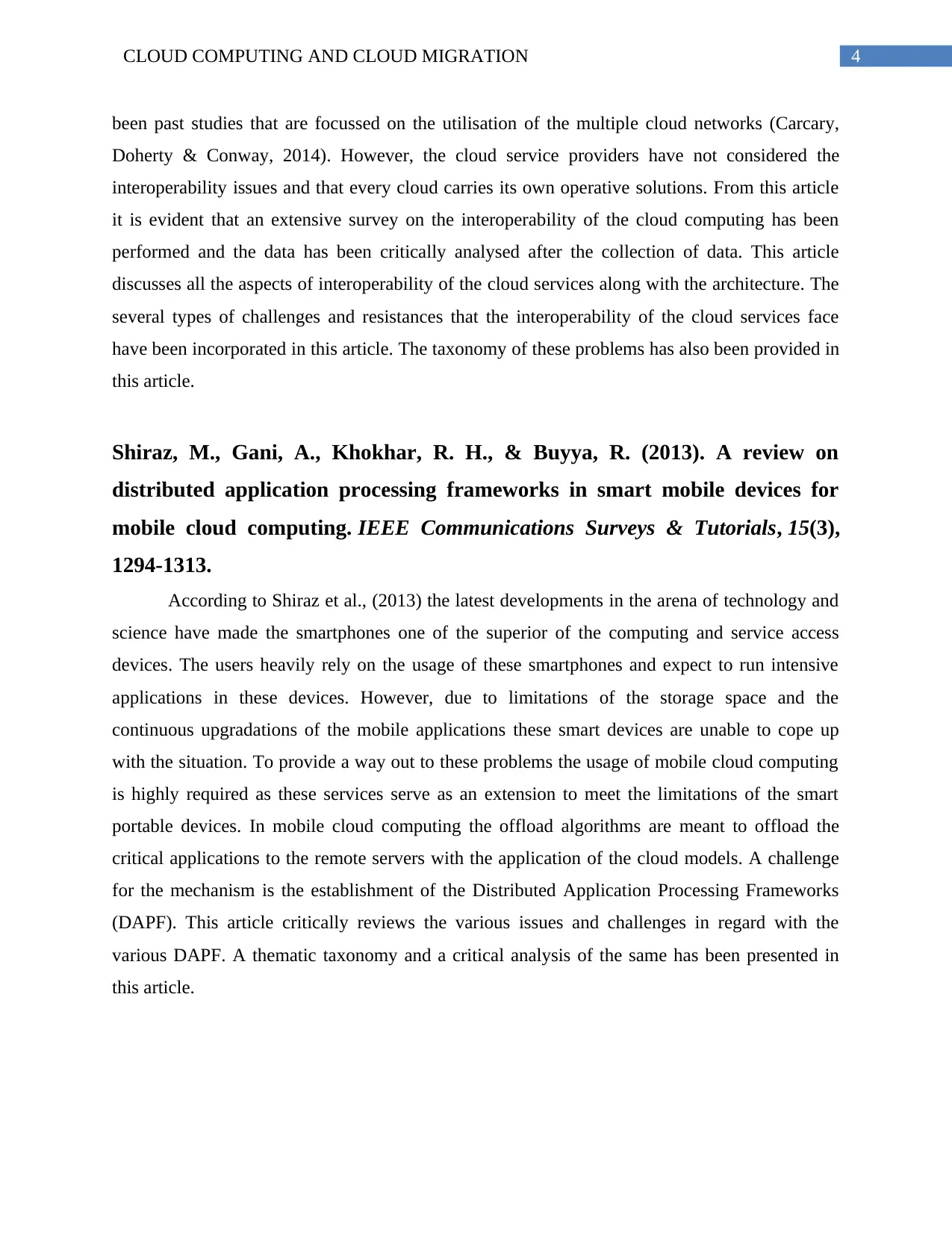
4CLOUD COMPUTING AND CLOUD MIGRATION
been past studies that are focussed on the utilisation of the multiple cloud networks (Carcary,
Doherty & Conway, 2014). However, the cloud service providers have not considered the
interoperability issues and that every cloud carries its own operative solutions. From this article
it is evident that an extensive survey on the interoperability of the cloud computing has been
performed and the data has been critically analysed after the collection of data. This article
discusses all the aspects of interoperability of the cloud services along with the architecture. The
several types of challenges and resistances that the interoperability of the cloud services face
have been incorporated in this article. The taxonomy of these problems has also been provided in
this article.
Shiraz, M., Gani, A., Khokhar, R. H., & Buyya, R. (2013). A review on
distributed application processing frameworks in smart mobile devices for
mobile cloud computing. IEEE Communications Surveys & Tutorials, 15(3),
1294-1313.
According to Shiraz et al., (2013) the latest developments in the arena of technology and
science have made the smartphones one of the superior of the computing and service access
devices. The users heavily rely on the usage of these smartphones and expect to run intensive
applications in these devices. However, due to limitations of the storage space and the
continuous upgradations of the mobile applications these smart devices are unable to cope up
with the situation. To provide a way out to these problems the usage of mobile cloud computing
is highly required as these services serve as an extension to meet the limitations of the smart
portable devices. In mobile cloud computing the offload algorithms are meant to offload the
critical applications to the remote servers with the application of the cloud models. A challenge
for the mechanism is the establishment of the Distributed Application Processing Frameworks
(DAPF). This article critically reviews the various issues and challenges in regard with the
various DAPF. A thematic taxonomy and a critical analysis of the same has been presented in
this article.
been past studies that are focussed on the utilisation of the multiple cloud networks (Carcary,
Doherty & Conway, 2014). However, the cloud service providers have not considered the
interoperability issues and that every cloud carries its own operative solutions. From this article
it is evident that an extensive survey on the interoperability of the cloud computing has been
performed and the data has been critically analysed after the collection of data. This article
discusses all the aspects of interoperability of the cloud services along with the architecture. The
several types of challenges and resistances that the interoperability of the cloud services face
have been incorporated in this article. The taxonomy of these problems has also been provided in
this article.
Shiraz, M., Gani, A., Khokhar, R. H., & Buyya, R. (2013). A review on
distributed application processing frameworks in smart mobile devices for
mobile cloud computing. IEEE Communications Surveys & Tutorials, 15(3),
1294-1313.
According to Shiraz et al., (2013) the latest developments in the arena of technology and
science have made the smartphones one of the superior of the computing and service access
devices. The users heavily rely on the usage of these smartphones and expect to run intensive
applications in these devices. However, due to limitations of the storage space and the
continuous upgradations of the mobile applications these smart devices are unable to cope up
with the situation. To provide a way out to these problems the usage of mobile cloud computing
is highly required as these services serve as an extension to meet the limitations of the smart
portable devices. In mobile cloud computing the offload algorithms are meant to offload the
critical applications to the remote servers with the application of the cloud models. A challenge
for the mechanism is the establishment of the Distributed Application Processing Frameworks
(DAPF). This article critically reviews the various issues and challenges in regard with the
various DAPF. A thematic taxonomy and a critical analysis of the same has been presented in
this article.
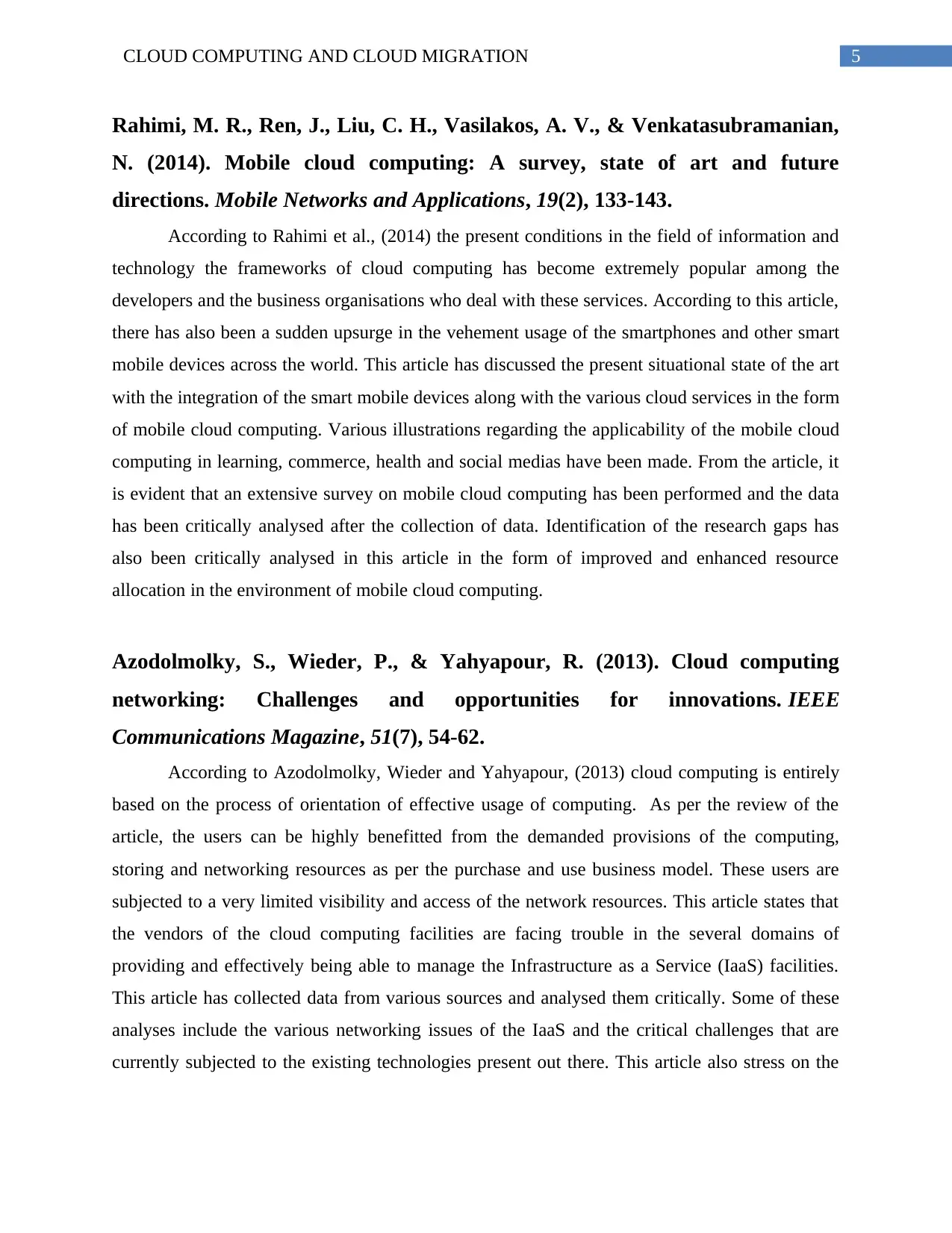
5CLOUD COMPUTING AND CLOUD MIGRATION
Rahimi, M. R., Ren, J., Liu, C. H., Vasilakos, A. V., & Venkatasubramanian,
N. (2014). Mobile cloud computing: A survey, state of art and future
directions. Mobile Networks and Applications, 19(2), 133-143.
According to Rahimi et al., (2014) the present conditions in the field of information and
technology the frameworks of cloud computing has become extremely popular among the
developers and the business organisations who deal with these services. According to this article,
there has also been a sudden upsurge in the vehement usage of the smartphones and other smart
mobile devices across the world. This article has discussed the present situational state of the art
with the integration of the smart mobile devices along with the various cloud services in the form
of mobile cloud computing. Various illustrations regarding the applicability of the mobile cloud
computing in learning, commerce, health and social medias have been made. From the article, it
is evident that an extensive survey on mobile cloud computing has been performed and the data
has been critically analysed after the collection of data. Identification of the research gaps has
also been critically analysed in this article in the form of improved and enhanced resource
allocation in the environment of mobile cloud computing.
Azodolmolky, S., Wieder, P., & Yahyapour, R. (2013). Cloud computing
networking: Challenges and opportunities for innovations. IEEE
Communications Magazine, 51(7), 54-62.
According to Azodolmolky, Wieder and Yahyapour, (2013) cloud computing is entirely
based on the process of orientation of effective usage of computing. As per the review of the
article, the users can be highly benefitted from the demanded provisions of the computing,
storing and networking resources as per the purchase and use business model. These users are
subjected to a very limited visibility and access of the network resources. This article states that
the vendors of the cloud computing facilities are facing trouble in the several domains of
providing and effectively being able to manage the Infrastructure as a Service (IaaS) facilities.
This article has collected data from various sources and analysed them critically. Some of these
analyses include the various networking issues of the IaaS and the critical challenges that are
currently subjected to the existing technologies present out there. This article also stress on the
Rahimi, M. R., Ren, J., Liu, C. H., Vasilakos, A. V., & Venkatasubramanian,
N. (2014). Mobile cloud computing: A survey, state of art and future
directions. Mobile Networks and Applications, 19(2), 133-143.
According to Rahimi et al., (2014) the present conditions in the field of information and
technology the frameworks of cloud computing has become extremely popular among the
developers and the business organisations who deal with these services. According to this article,
there has also been a sudden upsurge in the vehement usage of the smartphones and other smart
mobile devices across the world. This article has discussed the present situational state of the art
with the integration of the smart mobile devices along with the various cloud services in the form
of mobile cloud computing. Various illustrations regarding the applicability of the mobile cloud
computing in learning, commerce, health and social medias have been made. From the article, it
is evident that an extensive survey on mobile cloud computing has been performed and the data
has been critically analysed after the collection of data. Identification of the research gaps has
also been critically analysed in this article in the form of improved and enhanced resource
allocation in the environment of mobile cloud computing.
Azodolmolky, S., Wieder, P., & Yahyapour, R. (2013). Cloud computing
networking: Challenges and opportunities for innovations. IEEE
Communications Magazine, 51(7), 54-62.
According to Azodolmolky, Wieder and Yahyapour, (2013) cloud computing is entirely
based on the process of orientation of effective usage of computing. As per the review of the
article, the users can be highly benefitted from the demanded provisions of the computing,
storing and networking resources as per the purchase and use business model. These users are
subjected to a very limited visibility and access of the network resources. This article states that
the vendors of the cloud computing facilities are facing trouble in the several domains of
providing and effectively being able to manage the Infrastructure as a Service (IaaS) facilities.
This article has collected data from various sources and analysed them critically. Some of these
analyses include the various networking issues of the IaaS and the critical challenges that are
currently subjected to the existing technologies present out there. This article also stress on the
⊘ This is a preview!⊘
Do you want full access?
Subscribe today to unlock all pages.

Trusted by 1+ million students worldwide
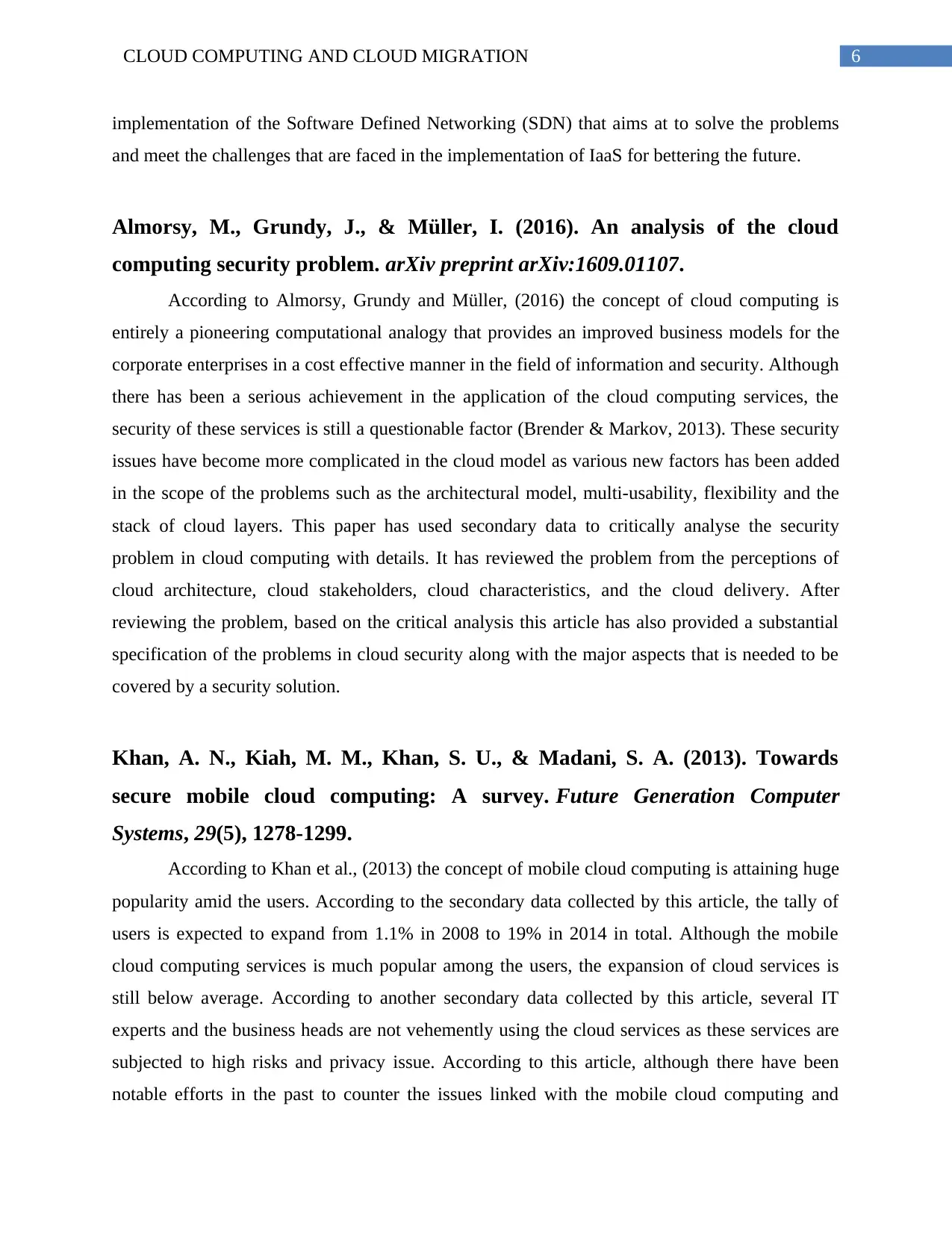
6CLOUD COMPUTING AND CLOUD MIGRATION
implementation of the Software Defined Networking (SDN) that aims at to solve the problems
and meet the challenges that are faced in the implementation of IaaS for bettering the future.
Almorsy, M., Grundy, J., & Müller, I. (2016). An analysis of the cloud
computing security problem. arXiv preprint arXiv:1609.01107.
According to Almorsy, Grundy and Müller, (2016) the concept of cloud computing is
entirely a pioneering computational analogy that provides an improved business models for the
corporate enterprises in a cost effective manner in the field of information and security. Although
there has been a serious achievement in the application of the cloud computing services, the
security of these services is still a questionable factor (Brender & Markov, 2013). These security
issues have become more complicated in the cloud model as various new factors has been added
in the scope of the problems such as the architectural model, multi-usability, flexibility and the
stack of cloud layers. This paper has used secondary data to critically analyse the security
problem in cloud computing with details. It has reviewed the problem from the perceptions of
cloud architecture, cloud stakeholders, cloud characteristics, and the cloud delivery. After
reviewing the problem, based on the critical analysis this article has also provided a substantial
specification of the problems in cloud security along with the major aspects that is needed to be
covered by a security solution.
Khan, A. N., Kiah, M. M., Khan, S. U., & Madani, S. A. (2013). Towards
secure mobile cloud computing: A survey. Future Generation Computer
Systems, 29(5), 1278-1299.
According to Khan et al., (2013) the concept of mobile cloud computing is attaining huge
popularity amid the users. According to the secondary data collected by this article, the tally of
users is expected to expand from 1.1% in 2008 to 19% in 2014 in total. Although the mobile
cloud computing services is much popular among the users, the expansion of cloud services is
still below average. According to another secondary data collected by this article, several IT
experts and the business heads are not vehemently using the cloud services as these services are
subjected to high risks and privacy issue. According to this article, although there have been
notable efforts in the past to counter the issues linked with the mobile cloud computing and
implementation of the Software Defined Networking (SDN) that aims at to solve the problems
and meet the challenges that are faced in the implementation of IaaS for bettering the future.
Almorsy, M., Grundy, J., & Müller, I. (2016). An analysis of the cloud
computing security problem. arXiv preprint arXiv:1609.01107.
According to Almorsy, Grundy and Müller, (2016) the concept of cloud computing is
entirely a pioneering computational analogy that provides an improved business models for the
corporate enterprises in a cost effective manner in the field of information and security. Although
there has been a serious achievement in the application of the cloud computing services, the
security of these services is still a questionable factor (Brender & Markov, 2013). These security
issues have become more complicated in the cloud model as various new factors has been added
in the scope of the problems such as the architectural model, multi-usability, flexibility and the
stack of cloud layers. This paper has used secondary data to critically analyse the security
problem in cloud computing with details. It has reviewed the problem from the perceptions of
cloud architecture, cloud stakeholders, cloud characteristics, and the cloud delivery. After
reviewing the problem, based on the critical analysis this article has also provided a substantial
specification of the problems in cloud security along with the major aspects that is needed to be
covered by a security solution.
Khan, A. N., Kiah, M. M., Khan, S. U., & Madani, S. A. (2013). Towards
secure mobile cloud computing: A survey. Future Generation Computer
Systems, 29(5), 1278-1299.
According to Khan et al., (2013) the concept of mobile cloud computing is attaining huge
popularity amid the users. According to the secondary data collected by this article, the tally of
users is expected to expand from 1.1% in 2008 to 19% in 2014 in total. Although the mobile
cloud computing services is much popular among the users, the expansion of cloud services is
still below average. According to another secondary data collected by this article, several IT
experts and the business heads are not vehemently using the cloud services as these services are
subjected to high risks and privacy issue. According to this article, although there have been
notable efforts in the past to counter the issues linked with the mobile cloud computing and
Paraphrase This Document
Need a fresh take? Get an instant paraphrase of this document with our AI Paraphraser
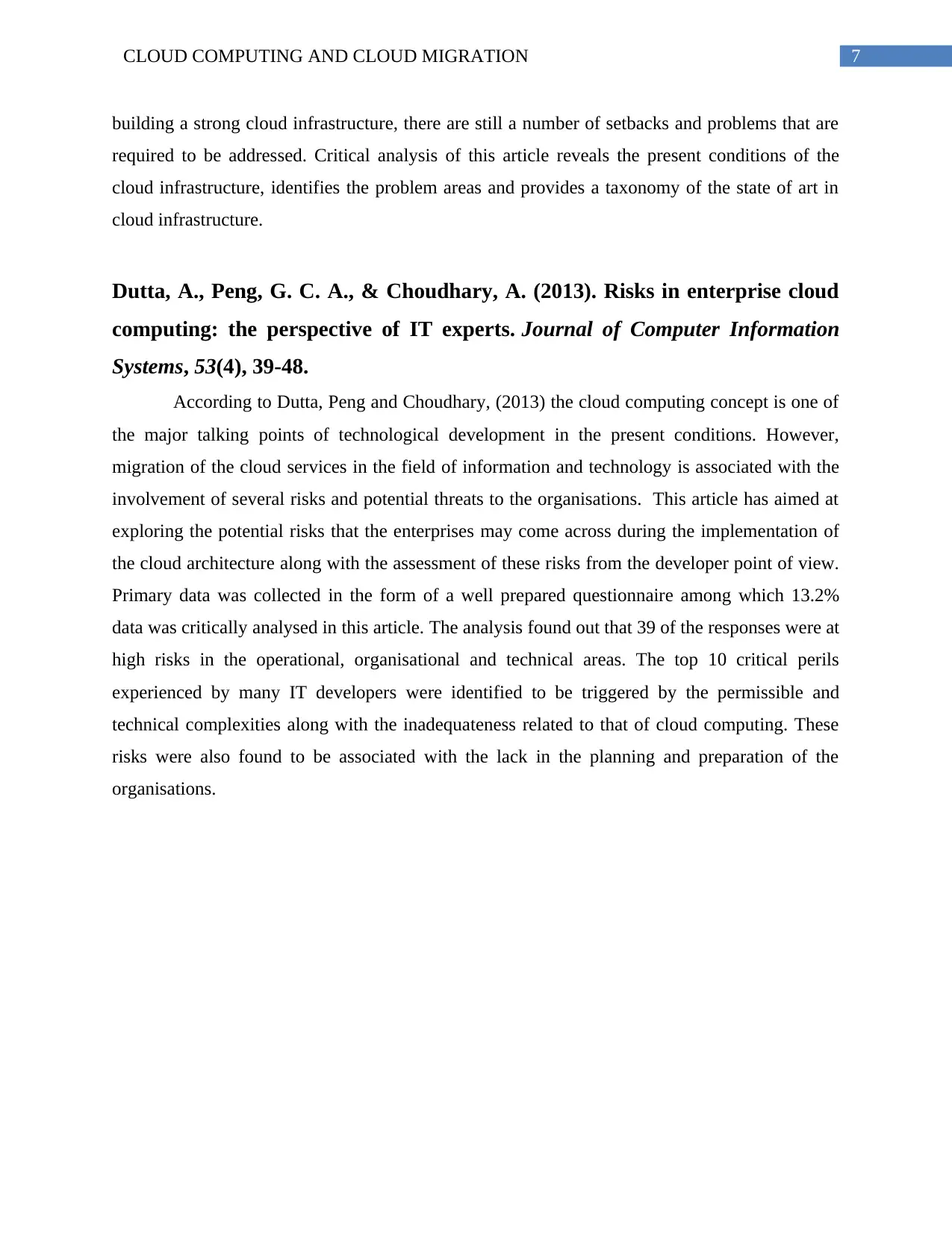
7CLOUD COMPUTING AND CLOUD MIGRATION
building a strong cloud infrastructure, there are still a number of setbacks and problems that are
required to be addressed. Critical analysis of this article reveals the present conditions of the
cloud infrastructure, identifies the problem areas and provides a taxonomy of the state of art in
cloud infrastructure.
Dutta, A., Peng, G. C. A., & Choudhary, A. (2013). Risks in enterprise cloud
computing: the perspective of IT experts. Journal of Computer Information
Systems, 53(4), 39-48.
According to Dutta, Peng and Choudhary, (2013) the cloud computing concept is one of
the major talking points of technological development in the present conditions. However,
migration of the cloud services in the field of information and technology is associated with the
involvement of several risks and potential threats to the organisations. This article has aimed at
exploring the potential risks that the enterprises may come across during the implementation of
the cloud architecture along with the assessment of these risks from the developer point of view.
Primary data was collected in the form of a well prepared questionnaire among which 13.2%
data was critically analysed in this article. The analysis found out that 39 of the responses were at
high risks in the operational, organisational and technical areas. The top 10 critical perils
experienced by many IT developers were identified to be triggered by the permissible and
technical complexities along with the inadequateness related to that of cloud computing. These
risks were also found to be associated with the lack in the planning and preparation of the
organisations.
building a strong cloud infrastructure, there are still a number of setbacks and problems that are
required to be addressed. Critical analysis of this article reveals the present conditions of the
cloud infrastructure, identifies the problem areas and provides a taxonomy of the state of art in
cloud infrastructure.
Dutta, A., Peng, G. C. A., & Choudhary, A. (2013). Risks in enterprise cloud
computing: the perspective of IT experts. Journal of Computer Information
Systems, 53(4), 39-48.
According to Dutta, Peng and Choudhary, (2013) the cloud computing concept is one of
the major talking points of technological development in the present conditions. However,
migration of the cloud services in the field of information and technology is associated with the
involvement of several risks and potential threats to the organisations. This article has aimed at
exploring the potential risks that the enterprises may come across during the implementation of
the cloud architecture along with the assessment of these risks from the developer point of view.
Primary data was collected in the form of a well prepared questionnaire among which 13.2%
data was critically analysed in this article. The analysis found out that 39 of the responses were at
high risks in the operational, organisational and technical areas. The top 10 critical perils
experienced by many IT developers were identified to be triggered by the permissible and
technical complexities along with the inadequateness related to that of cloud computing. These
risks were also found to be associated with the lack in the planning and preparation of the
organisations.
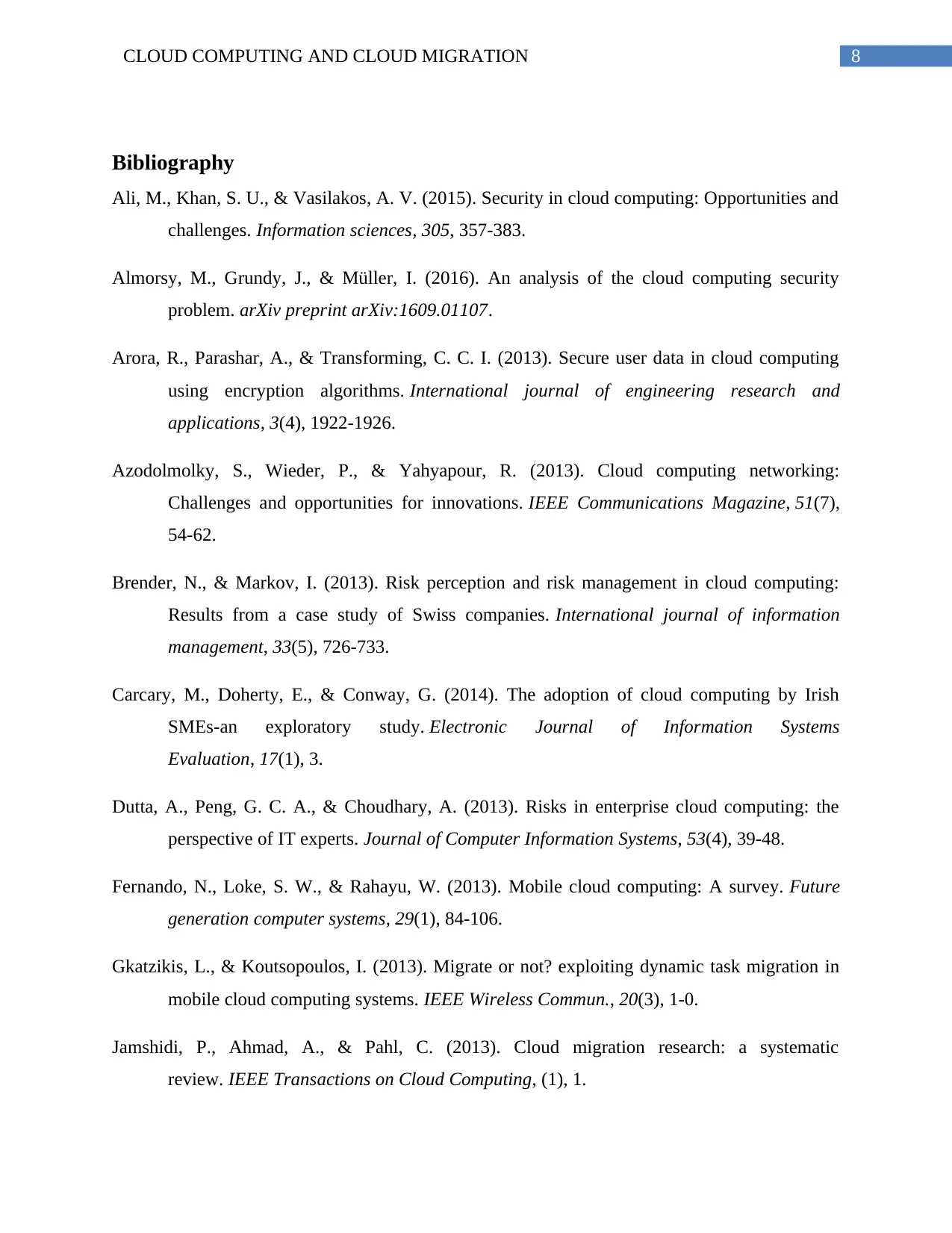
8CLOUD COMPUTING AND CLOUD MIGRATION
Bibliography
Ali, M., Khan, S. U., & Vasilakos, A. V. (2015). Security in cloud computing: Opportunities and
challenges. Information sciences, 305, 357-383.
Almorsy, M., Grundy, J., & Müller, I. (2016). An analysis of the cloud computing security
problem. arXiv preprint arXiv:1609.01107.
Arora, R., Parashar, A., & Transforming, C. C. I. (2013). Secure user data in cloud computing
using encryption algorithms. International journal of engineering research and
applications, 3(4), 1922-1926.
Azodolmolky, S., Wieder, P., & Yahyapour, R. (2013). Cloud computing networking:
Challenges and opportunities for innovations. IEEE Communications Magazine, 51(7),
54-62.
Brender, N., & Markov, I. (2013). Risk perception and risk management in cloud computing:
Results from a case study of Swiss companies. International journal of information
management, 33(5), 726-733.
Carcary, M., Doherty, E., & Conway, G. (2014). The adoption of cloud computing by Irish
SMEs-an exploratory study. Electronic Journal of Information Systems
Evaluation, 17(1), 3.
Dutta, A., Peng, G. C. A., & Choudhary, A. (2013). Risks in enterprise cloud computing: the
perspective of IT experts. Journal of Computer Information Systems, 53(4), 39-48.
Fernando, N., Loke, S. W., & Rahayu, W. (2013). Mobile cloud computing: A survey. Future
generation computer systems, 29(1), 84-106.
Gkatzikis, L., & Koutsopoulos, I. (2013). Migrate or not? exploiting dynamic task migration in
mobile cloud computing systems. IEEE Wireless Commun., 20(3), 1-0.
Jamshidi, P., Ahmad, A., & Pahl, C. (2013). Cloud migration research: a systematic
review. IEEE Transactions on Cloud Computing, (1), 1.
Bibliography
Ali, M., Khan, S. U., & Vasilakos, A. V. (2015). Security in cloud computing: Opportunities and
challenges. Information sciences, 305, 357-383.
Almorsy, M., Grundy, J., & Müller, I. (2016). An analysis of the cloud computing security
problem. arXiv preprint arXiv:1609.01107.
Arora, R., Parashar, A., & Transforming, C. C. I. (2013). Secure user data in cloud computing
using encryption algorithms. International journal of engineering research and
applications, 3(4), 1922-1926.
Azodolmolky, S., Wieder, P., & Yahyapour, R. (2013). Cloud computing networking:
Challenges and opportunities for innovations. IEEE Communications Magazine, 51(7),
54-62.
Brender, N., & Markov, I. (2013). Risk perception and risk management in cloud computing:
Results from a case study of Swiss companies. International journal of information
management, 33(5), 726-733.
Carcary, M., Doherty, E., & Conway, G. (2014). The adoption of cloud computing by Irish
SMEs-an exploratory study. Electronic Journal of Information Systems
Evaluation, 17(1), 3.
Dutta, A., Peng, G. C. A., & Choudhary, A. (2013). Risks in enterprise cloud computing: the
perspective of IT experts. Journal of Computer Information Systems, 53(4), 39-48.
Fernando, N., Loke, S. W., & Rahayu, W. (2013). Mobile cloud computing: A survey. Future
generation computer systems, 29(1), 84-106.
Gkatzikis, L., & Koutsopoulos, I. (2013). Migrate or not? exploiting dynamic task migration in
mobile cloud computing systems. IEEE Wireless Commun., 20(3), 1-0.
Jamshidi, P., Ahmad, A., & Pahl, C. (2013). Cloud migration research: a systematic
review. IEEE Transactions on Cloud Computing, (1), 1.
⊘ This is a preview!⊘
Do you want full access?
Subscribe today to unlock all pages.

Trusted by 1+ million students worldwide
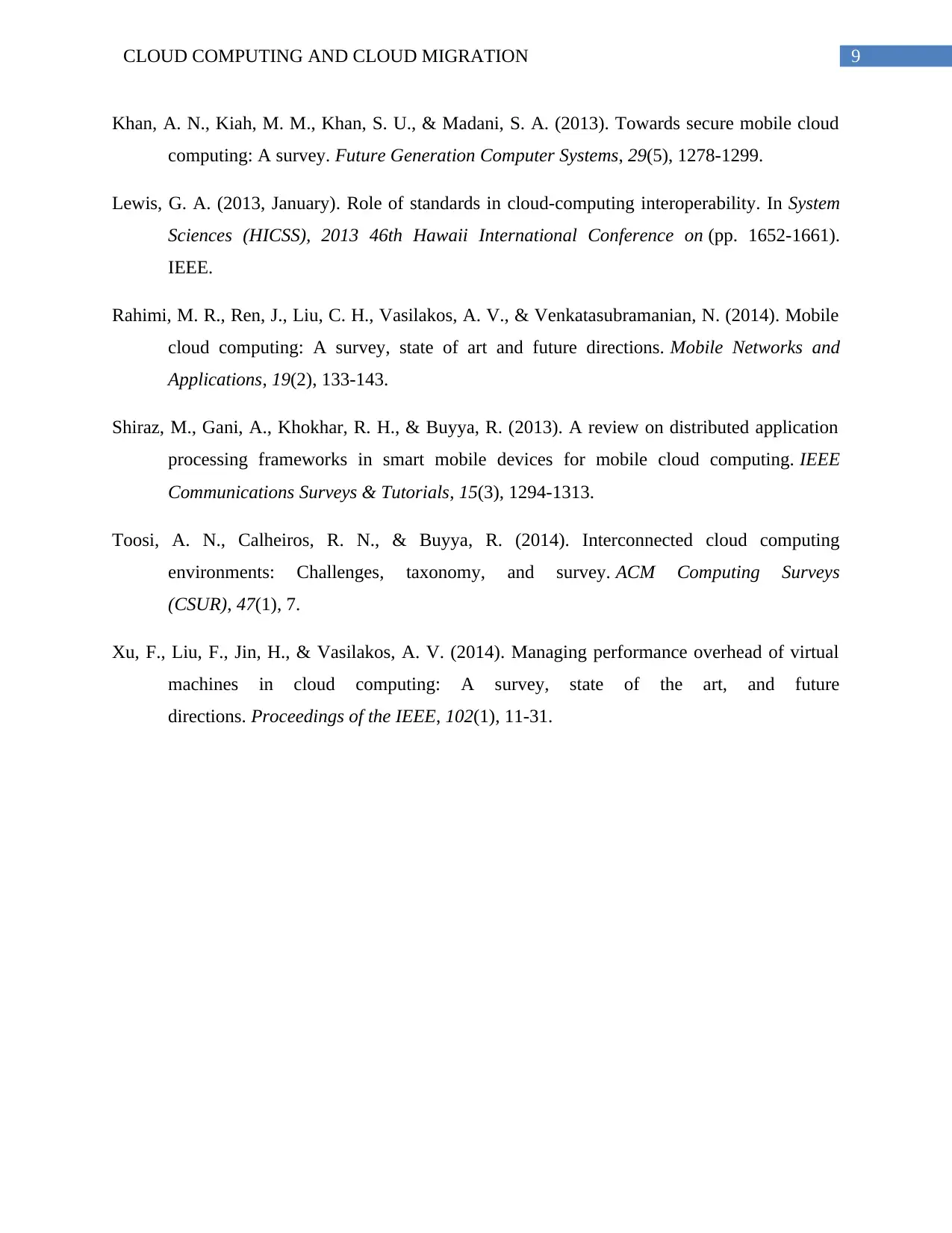
9CLOUD COMPUTING AND CLOUD MIGRATION
Khan, A. N., Kiah, M. M., Khan, S. U., & Madani, S. A. (2013). Towards secure mobile cloud
computing: A survey. Future Generation Computer Systems, 29(5), 1278-1299.
Lewis, G. A. (2013, January). Role of standards in cloud-computing interoperability. In System
Sciences (HICSS), 2013 46th Hawaii International Conference on (pp. 1652-1661).
IEEE.
Rahimi, M. R., Ren, J., Liu, C. H., Vasilakos, A. V., & Venkatasubramanian, N. (2014). Mobile
cloud computing: A survey, state of art and future directions. Mobile Networks and
Applications, 19(2), 133-143.
Shiraz, M., Gani, A., Khokhar, R. H., & Buyya, R. (2013). A review on distributed application
processing frameworks in smart mobile devices for mobile cloud computing. IEEE
Communications Surveys & Tutorials, 15(3), 1294-1313.
Toosi, A. N., Calheiros, R. N., & Buyya, R. (2014). Interconnected cloud computing
environments: Challenges, taxonomy, and survey. ACM Computing Surveys
(CSUR), 47(1), 7.
Xu, F., Liu, F., Jin, H., & Vasilakos, A. V. (2014). Managing performance overhead of virtual
machines in cloud computing: A survey, state of the art, and future
directions. Proceedings of the IEEE, 102(1), 11-31.
Khan, A. N., Kiah, M. M., Khan, S. U., & Madani, S. A. (2013). Towards secure mobile cloud
computing: A survey. Future Generation Computer Systems, 29(5), 1278-1299.
Lewis, G. A. (2013, January). Role of standards in cloud-computing interoperability. In System
Sciences (HICSS), 2013 46th Hawaii International Conference on (pp. 1652-1661).
IEEE.
Rahimi, M. R., Ren, J., Liu, C. H., Vasilakos, A. V., & Venkatasubramanian, N. (2014). Mobile
cloud computing: A survey, state of art and future directions. Mobile Networks and
Applications, 19(2), 133-143.
Shiraz, M., Gani, A., Khokhar, R. H., & Buyya, R. (2013). A review on distributed application
processing frameworks in smart mobile devices for mobile cloud computing. IEEE
Communications Surveys & Tutorials, 15(3), 1294-1313.
Toosi, A. N., Calheiros, R. N., & Buyya, R. (2014). Interconnected cloud computing
environments: Challenges, taxonomy, and survey. ACM Computing Surveys
(CSUR), 47(1), 7.
Xu, F., Liu, F., Jin, H., & Vasilakos, A. V. (2014). Managing performance overhead of virtual
machines in cloud computing: A survey, state of the art, and future
directions. Proceedings of the IEEE, 102(1), 11-31.
1 out of 10
Related Documents
Your All-in-One AI-Powered Toolkit for Academic Success.
+13062052269
info@desklib.com
Available 24*7 on WhatsApp / Email
![[object Object]](/_next/static/media/star-bottom.7253800d.svg)
Unlock your academic potential
Copyright © 2020–2025 A2Z Services. All Rights Reserved. Developed and managed by ZUCOL.



